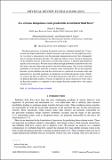| dc.contributor.author | Blonigan, Patrick J. | |
| dc.contributor.author | Farazmand, Mohammad M | |
| dc.contributor.author | Sapsis, Themistoklis Panagiotis | |
| dc.date.accessioned | 2020-08-26T14:56:22Z | |
| dc.date.available | 2020-08-26T14:56:22Z | |
| dc.date.issued | 2019-04 | |
| dc.date.submitted | 2018-07 | |
| dc.identifier.issn | 2469-990X | |
| dc.identifier.uri | https://hdl.handle.net/1721.1/126815 | |
| dc.description.abstract | We derive precursors of extreme dissipation events in a turbulent channel flow. Using a recently developed method that combines dynamics and statistics for the underlying attractor, we extract a characteristic state that precedes laminarization events that subsequently lead to extreme dissipation episodes. Our approach utilizes coarse statistical information for the turbulent attractor, in the form of second-order statistics, to identify high-likelihood regions in the state space. We then search within this high-probability manifold for the state that leads to the most finite-time growth of the flow kinetic energy. This state has both high probability of occurrence and leads to extreme values of dissipation. We use the alignment between a given turbulent state and this critical state as a precursor for extreme events and demonstrate its favorable properties for prediction of extreme dissipation events. Finally, we analyze the physical relevance of the derived precursor and show its robust character for different Reynolds numbers. Overall, we find that our choice of precursor works well at the Reynolds number it is computed at and at higher Reynolds number flows with similar extreme events. | en_US |
| dc.description.sponsorship | Army Research Office (Contract W911NF-17-1-0306) | en_US |
| dc.description.sponsorship | Office of Naval Research (Grant N00014-15-1-2381) | en_US |
| dc.language.iso | en | |
| dc.publisher | American Physical Society (APS) | en_US |
| dc.relation.isversionof | http://dx.doi.org/10.1103/physrevfluids.4.044606 | en_US |
| dc.rights | Article is made available in accordance with the publisher's policy and may be subject to US copyright law. Please refer to the publisher's site for terms of use. | en_US |
| dc.source | APS | en_US |
| dc.title | Are extreme dissipation events predictable in turbulent fluid flows? | en_US |
| dc.type | Article | en_US |
| dc.identifier.citation | Blonigan, Patrick J. et al. "Are extreme dissipation events predictable in turbulent fluid flows?." Physical Review Fluids 4, 4 (April 2019): 044606 © 2019 American Physical Society | en_US |
| dc.contributor.department | Massachusetts Institute of Technology. Department of Mechanical Engineering | en_US |
| dc.relation.journal | Physical Review Fluids | en_US |
| dc.eprint.version | Final published version | en_US |
| dc.type.uri | http://purl.org/eprint/type/JournalArticle | en_US |
| eprint.status | http://purl.org/eprint/status/PeerReviewed | en_US |
| dc.date.updated | 2020-08-03T17:48:58Z | |
| dspace.date.submission | 2020-08-03T17:49:02Z | |
| mit.journal.volume | 4 | en_US |
| mit.journal.issue | 4 | en_US |
| mit.license | PUBLISHER_POLICY | |
| mit.metadata.status | Complete | |
